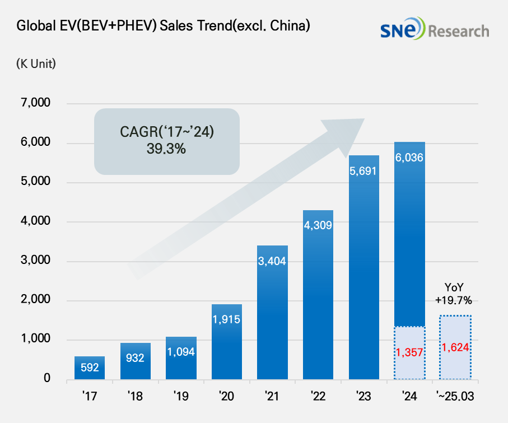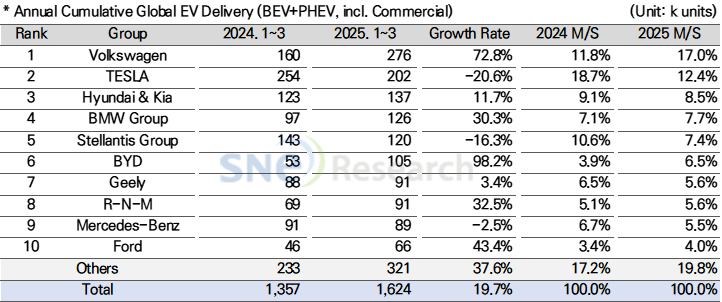From Jan to Mar 2025, Non-China Global Electric Vehicle Deliveries Reached Approx. 1.624 Mil Units, a 19.7% YoY Growth
-
Tesla falls to second place due to the impact of declining sales in the
European market
From
Jan to Mar 2025, the total number of electric vehicles registered in countries
outside China was approximately 1.624 million units, a 19.7% YoY increase.

(Source: 2025 Apr Global Monthly EV and Battery Monthly Tracker, SNE Research)
From
Jan to Mar 2025, Volkswagen Group ranked No. 1 in EV sales outside China,
selling approx. 276k units, a 72.8% YoY increase, overtaking Tesla. The strong
performance was driven by solid sales of MEB platform-based models such as the
ID.3, ID.4, ID.7, Q4 e-Tron, and ENYAQ. Tesla fell to second place with approx.
202k units sold, down 20.6% YoY, due to decreased sales of its key models,
Model 3 and Model Y. In Europe, sales dropped 34.2% YoY, and in North America,
8.1% YoY, reflecting weak performance in major markets. The decline in European
sales was mainly due to halted production and low inventory ahead of the launch
of the facelifted Model Y (“Juniper”), which is seen as a temporary issue.
Tesla had planned to release a more affordable model to offset the downturn,
but production has been delayed by at least three months, possibly pushing the
launch to late 2025 or early 2026.
Hyundai Motor Group ranked
3rd, selling approximately 137k units and recording a 11.7% YoY growth. Its
main models, the IONIQ 5 and EV6, have led the recovery in sales thanks to
improved product competitiveness through their 2025 facelifts, while Kia’s EV3
and EV9 are also continuing to expand their global sales. In particular,
Hyundai Motor Group has shown notable performance in the North American market
by surpassing the electric vehicle deliveries of Stellantis, Ford, and GM. Kia
clearly demonstrated its commitment to EV popularization by unveiling the
compact electrified sedan EV4 and the small electric SUV concept car EV2. EV4
offers a maximum range of up to 533 km per charge (based on the WLTP standard)
for its long-range model, which is among the longest in Hyundai Motor Group’s
EV lineup and meets demand for long-distance driving. Along with the EV4, the
EV2 – a small electric SUV targeting the European market – is also being
prepared for launch, as part of Kia’s strategy to further strengthen its EV
competitiveness in Europe.

(Source:
2025 Apr Global Monthly EV and Battery Monthly Tracker, SNE Research)
By region, the European
market showed signs of recovery, recording approximately 22.8% YoY growth in
sales. The launch of various new models such as Renault’s small hatchback EV
“R5,” Stellantis’s “e-C3,” Kia’s EV3, and Hyundai’s Casper Electric (Inster)
helped boost market momentum. In particular, BYD is constructing a
Europe-dedicated plant in Szeged, Hungary, with an annual production capacity
of 200k units. The plant, covering an area of 300 hectares, is expected to
become a key hub in BYD’s strategy to expand in the European market. Meanwhile,
considering the burden on automakers, the EU has postponed the application of
CO₂
emission regulations to 2027. As a result, manufacturers will be able to meet
the regulations based on the average emissions between 2025 and 2027. This is
interpreted as a measure to bridge the gap between the pace of EV transition
and practical realities.
The North American market
grew by 6.6%, accounting for 25.5% of the global market share. Due to tax
credit benefits under the U.S. Inflation Reduction Act (IRA), major
manufacturers such as GM, Ford, and Hyundai Motor Group are increasing their
share of local production in North America. However, as the Trump
administration is reportedly considering the repeal of EV sales mandates,
reduction of EV subsidies, and the imposition of tariffs on battery raw
materials, there is a growing possibility of increased market uncertainty in
the future. Accordingly, automakers need to develop flexible strategies to
respond to policy changes and focus on building a well-balanced portfolio
between internal combustion engine vehicles and electric vehicles.
The electric vehicle market
in Asia (excluding China) grew by 30.8% YoY, accounting for 14.3% of the global
market share. While growth continues, the overall upward trend remains moderate
due to varying national policies and the strong presence of internal combustion
engine and hybrid vehicles. Japan has traditionally maintained a hybrid-focused
strategy, but recently, brands like Toyota and Lexus have begun launching new
battery electric vehicle (BEV) models, signaling moves to expand their presence
in the EV market. India is accelerating market expansion through proactive EV
promotion policies. The Indian government aims to increase the EV share to 30%
of total vehicle sales by 2030 and is working to improve subsidy schemes and
expand charging infrastructure to support this goal.

(Source: 2025 Apr Global Monthly EV and
Battery Monthly Tracker, SNE Research)
The global electric vehicle market continues to show gradual growth even outside of China, though the driving forces vary by region. In Europe, price competitiveness and model diversity are key factors supporting market recovery. North America faces a complex landscape where policy benefits and risks coexist amid political uncertainty. Major Asian countries are pursuing EV transitions at their own pace, seeking a balance between protecting domestic industries and expanding adoption. As regional policy directions and demand structures become increasingly distinct, global automakers are refining their market strategies and strengthening their positions in key markets.

